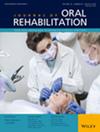Does Proprioceptive Neuromuscular Facilitation Approach Have an Effect on Swallowing Function, Muscle Morphology and Quality of Life in Dysphagic Stroke Patients? A Randomised Controlled Trial
Abstract
Objective
To investigate the effects of different exercise methods on swallowing function in dysphagic stroke patients.
Methods
Forty-two patients with dysphagia were divided into three groups: conventional swallowing exercises group; the proprioceptive neuromuscular facilitation (PNF) exercises + conventional swallowing exercises group and the Chin-tuck Against Resistance (CTAR) exercises + conventional swallowing exercises. Patients received swallowing rehabilitation twice a week for 8 weeks. Patients were evaluated for swallowing using Fiberoptic Endoscopic Evaluation of Swallowing (FEES) with the Penetration-Aspiration Scale. Suprahyoid muscle thickness, tongue root area and hyolaryngeal elevation were measured by ultrasound before and after treatment. Furthermore, scales such as the National Institutes of Health (NIH) swallowing safety scale, Functional Oral Intake Scale (FOIS), Eating Assessment Tool-10 (EAT-10) and Swallowing Quality of Life Scale (SWAL-QOL) were utilised.
Results
The clinical and demographic characteristics of all three groups were similar at baseline (p > 0.05). Positive improvements were identified following treatment in terms of muscle thickness, as determined by FEES evaluation of swallowing functions and ultrasound evaluations, in all groups (p < 0.05). In the PAS liquid food evaluation, the highest effect was found in the PNF group (η2 = 0.858). All ultrasound evaluations showed greater improvement in the PNF and CTAR groups compared to the conventional group (p < 0.05). The SWAL QOL also showed significant improvements in all groups after treatment (p < 0.05).
Conclusion
In this study, all three groups contributed to swallowing rehabilitation, but the PNF group improved the most. PNF exercises, delivered by physical therapists without the need for specialised equipment, will make swallowing rehabilitation more effective.
Trial Registration
ClinicalTrials.gov identifier: NCT05678686


 求助内容:
求助内容: 应助结果提醒方式:
应助结果提醒方式:


